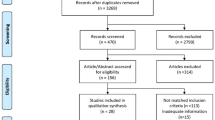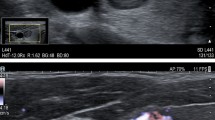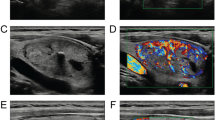Abstract
Objective
To evaluate the diagnostic performance of a commercial artificial intelligence (AI)–assisted ultrasonography (US) for thyroid nodules and to validate its value in real-world medical practice.
Materials and methods
From March 2021 to July 2021, 236 consecutive patients with 312 suspicious thyroid nodules were prospectively enrolled in this study. One experienced radiologist performed US examinations with a real-time AI system (S-Detect). US images and AI reports of the nodules were recorded. Nine residents and three senior radiologists were invited to make a “benign” or “malignant” diagnosis based on recorded US images without knowing the AI reports. After referring to AI reports, the diagnosis was made again. The diagnostic performance of AI, residents, and senior radiologists with and without AI reports were analyzed.
Results
The sensitivity, accuracy, and AUC of the AI system were 0.95, 0.84, and 0.753, respectively, and were not statistically different from those of the experienced radiologists, but were superior to those of the residents (all p < 0.01). The AI-assisted resident strategy significantly improved the accuracy and sensitivity for nodules ≤ 1.5 cm (all p < 0.01), while reducing the unnecessary biopsy rate by up to 27.7% for nodules > 1.5 cm (p = 0.034).
Conclusions
The AI system achieved performance, for cancer diagnosis, comparable to that of an average senior thyroid radiologist. The AI-assisted strategy can significantly improve the overall diagnostic performance for less-experienced radiologists, while increasing the discovery of thyroid cancer ≤ 1.5 cm and reducing unnecessary biopsies for nodules > 1.5 cm in real-world medical practice.
Key Points
• The AI system reached a senior radiologist-like level in the evaluation of thyroid cancer and could significantly improve the overall diagnostic performance of residents.
• The AI-assisted strategy significantly improved ≤ 1.5 cm thyroid cancer screening AUC, accuracy, and sensitivity of the residents, leading to an increased detection of thyroid cancer while maintaining a comparable specificity to that of radiologists alone.
• The AI-assisted strategy significantly reduced the unnecessary biopsy rate for thyroid nodules > 1.5 cm by the residents, while maintaining a comparable sensitivity to that of radiologists alone.




Similar content being viewed by others
Abbreviations
- AI:
-
Artificial intelligence
- CNB:
-
Core needle biopsy
- FNA:
-
Fine-needle aspiration
- PTC:
-
Papillary thyroid carcinoma
- US:
-
Ultrasonography
References
Chmielik E, Rusinek D, Oczko-Wojciechowska M et al (2018) Heterogeneity of thyroid cancer. Pathobiology 85:117–129
Sung H, Ferlay J, Siegel RL et al (2021) Global cancer statistics 2020: GLOBOCAN estimates of incidence and mortality worldwide for 36 cancers in 185 countries. CA Cancer J Clin 71:209–249
Miyauchi A, Ito Y, Oda H (2018) Insights into the management of papillary microcarcinoma of the thyroid. Thyroid 28:23–31
Kitahara C, Sosa J (2016) The changing incidence of thyroid cancer. Nat Rev Endocrinol 12:646–653
Haugen B, Alexander E, Bible K et al (2016) 2015 American Thyroid Association management guidelines for adult patients with thyroid nodules and differentiated thyroid cancer: the American Thyroid Association Guidelines Task Force on Thyroid Nodules and Differentiated Thyroid Cancer. Thyroid 26:1–133
Kim JH, Baek JH, Lim HK et al (2018) 2017 thyroid radiofrequency ablation guideline: Korean Society of Thyroid Radiology. Korean J Radiol 19:632–655
Gharib H, Papini E, Garber J et al (2016) American Association of Clinical Endocrinologists, American College of Endocrinology, and Associazione Medici Endocrinologi medical guidelines for clinical practice for the diagnosis and management of thyroid nodules--2016 update. Endocr Pract 22:622–639
Haddad R, Nasr C, Bischoff L et al (2018) NCCN guidelines insights: thyroid carcinoma, version 2.2018. J Natl Compr Cancer Netw 16:1429–1440
Melany M, Chen S (2017) Thyroid cancer: ultrasound imaging and fine-needle aspiration biopsy. Endocrinol Metab Clin N Am 46:691–711
Ozel A, Erturk SM, Ercan A et al (2012) The diagnostic efficiency of ultrasound in characterization for thyroid nodules: how many criteria are required to predict malignancy? Med Ultrason 14:24–28
Choi S, Kim E, Kwak J, Kim M, Son E (2010) Interobserver and intraobserver variations in ultrasound assessment of thyroid nodules. Thyroid 20:167–172
Wienke JR, Chong WK, Fielding JR, Zou KH, Mittelstaedt CA (2003) Sonographic features of benign thyroid nodules: interobserver reliability and overlap with malignancy. J Ultrasound Med 22:1027–1031
Kim SH, Park CS, Jung SL et al (2010) Observer variability and the performance between faculties and residents: US criteria for benign and malignant thyroid nodules. Korean J Radiol 11:149–155
Lee H, Yoon D, Seo Y et al (2018) Intraobserver and interobserver variability in ultrasound measurements of thyroid nodules. J Ultrasound Med 37:173–178
Sakorafas GH (2010) Thyroid nodules; interpretation and importance of fine-needle aspiration (FNA) for the clinician - practical considerations. Surg Oncol 19:e130–e139
Tuttle RM, Zhang L, Shaha A (2018) A clinical framework to facilitate selection of patients with differentiated thyroid cancer for active surveillance or less aggressive initial surgical management. Expert Rev Endocrinol Metab 13:77–85
Durante C, Grani G, Lamartina L, Filetti S, Mandel SJ, Cooper DS (2018) The diagnosis and management of thyroid nodules: a review. JAMA 319:914–924
Choi Y, Baek J, Park H et al (2017) A computer-aided diagnosis system using artificial intelligence for the diagnosis and characterization of thyroid nodules on ultrasound: initial clinical assessment. Thyroid 27:546–552
Yoo Y, Ha E, Cho Y, Kim H, Han M, Kang S (2018) Computer-aided diagnosis of thyroid nodules via ultrasonography: initial clinical experience. Korean J Radiol 19:665–672
Jeong E, Kim H, Ha E, Park S, Cho Y, Han M (2019) Computer-aided diagnosis system for thyroid nodules on ultrasonography: diagnostic performance and reproducibility based on the experience level of operators. Eur Radiol 29:1978–1985
Chung SR, Baek JH, Lee MK et al (2020) Computer-aided diagnosis system for the evaluation of thyroid nodules on ultrasonography: prospective non-inferiority study according to the experience level of radiologists. Korean J Radiol 21:369–376
Wei Q, Zeng S, Wang L et al (2020) The value of S-Detect in improving the diagnostic performance of radiologists for the differential diagnosis of thyroid nodules. Med Ultrason 22:415–423
Cibas ES, Ali SZ (2017) The 2017 Bethesda system for reporting thyroid cytopathology. Thyroid 27:1341–1346
Han M, Ha E, Park J (2021) Computer-aided diagnostic system for thyroid nodules on ultrasonography: diagnostic performance based on the thyroid imaging reporting and data system classification and dichotomous outcomes. AJNR Am J Neuroradiol 42:559–565
Kim H, Ha E, Han M (2019) Real-world performance of computer-aided diagnosis system for thyroid nodules using ultrasonography. Ultrasound Med Biol 45:2672–2678
Chambara N, Ying M (2019) The diagnostic efficiency of ultrasound computer-aided diagnosis in differentiating thyroid nodules: a systematic review and narrative synthesis. Cancers (Basel) 11
Zhao WJ, Fu LR, Huang ZM, Zhu JQ, Ma BY (2019) Effectiveness evaluation of computer-aided diagnosis system for the diagnosis of thyroid nodules on ultrasound: a systematic review and meta-analysis. Medicine (Baltimore) 98:e16379
Barczyński M, Stopa-Barczyńska M, Wojtczak B, Czarniecka A, Konturek A (2020) Clinical validation of S-Detect mode in semi-automated ultrasound classification of thyroid lesions in surgical office. Gland Surg 9:S77–S85
Funding
This study is supported by Beijing Municipal Science & Technology Commission (No. Z221100003522001).
Author information
Authors and Affiliations
Corresponding authors
Ethics declarations
Guarantor
The scientific guarantors of this publication are Mingbo Zhang and Yukun Luo.
Conflict of interest
The authors of this manuscript declare no relationships with any companies whose products or services may be related to the subject matter of the article.
Statistics and biometry
No complex statistical methods were necessary for this paper.
Informed consent
Written informed consent was obtained from all subjects (patients) in this study.
Ethical approval
Ethical approval was obtained from the Institutional Ethics Committee of the Chinese PLA General Hospital.
Methodology
• prospective
• diagnostic or prognostic study
• performed at one institution
Additional information
Publisher’s note
Springer Nature remains neutral with regard to jurisdictional claims in published maps and institutional affiliations.
Supplementary Information
ESM 1
(DOCX 57 kb)
Rights and permissions
Springer Nature or its licensor (e.g. a society or other partner) holds exclusive rights to this article under a publishing agreement with the author(s) or other rightsholder(s); author self-archiving of the accepted manuscript version of this article is solely governed by the terms of such publishing agreement and applicable law.
About this article
Cite this article
Li, Y., Liu, Y., Xiao, J. et al. Clinical value of artificial intelligence in thyroid ultrasound: a prospective study from the real world. Eur Radiol 33, 4513–4523 (2023). https://doi.org/10.1007/s00330-022-09378-y
Received:
Revised:
Accepted:
Published:
Issue Date:
DOI: https://doi.org/10.1007/s00330-022-09378-y




